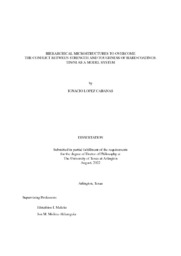
ATTENTION: The works hosted here are being migrated to a new repository that will consolidate resources, improve discoverability, and better show UTA's research impact on the global community. We will update authors as the migration progresses. Please see MavMatrix for more information.
Show simple item record
| dc.contributor.advisor | Cao, Ye | |
| dc.contributor.advisor | Meletis, Efstathios I | |
| dc.contributor.advisor | Molina-Aldareguia, Jon M | |
| dc.creator | Lopez Cabanas, Ignacio | |
| dc.date.accessioned | 2022-09-15T13:26:19Z | |
| dc.date.available | 2022-09-15T13:26:19Z | |
| dc.date.created | 2022-08 | |
| dc.date.issued | 2022-07-13 | |
| dc.date.submitted | August 2022 | |
| dc.identifier.uri | http://hdl.handle.net/10106/30957 | |
| dc.description.abstract | In the recent times, industry's production speed has been increasing and thus, the production of parts needs to adapt and so do the materials used to manufacture them. Hence, tools exposed to more extreme conditions using hard coatings need them to be more reliable.
In this work an improvement of the toughness of TiN/Ni coatings is achieved through the combination of different microstructures at different levels. This first part consisted on finding the optimum TiN/Ni composition by using a high throughput methodology for a faster analysis and the second on the combination of that composition with a multilayer structure to emulate nacre. The coatings prepared for the high throughput methodology were TiN/Ni with a Ni content ranging from 0 to 20 at.% in the same substrate by reactive magnetron sputtering with a continuous gradient. Since all the compositions were deposited under identical conditions any differences coming from deposition parameters are removed. By screening the mechanical properties, composition and microstructure it was found that TiN with around 10 at.%Ni presented the highest hardness and fracture toughness. These increments were found to be related to the formation a nanocomposite microstructure composed by equiaxed δ-TiN grains surrounded by an amorphous tissue phase. The hierarchical addition of Ni first to TiN and then a multilayer system presents a similar hardness to pure TiN but much higher toughness. Analysis on the fracture mechanisms revealed that in all cases the crack propagates through the grain boundaries and particle interfaces. Additionally, the coatings were tested at 500ºC, it was found that the multilayer system with TiN(10)Ni showed a ductile behaviour while the others were brittle, which is attributed to a higher Ni volume segregated into particles. | |
| dc.format.mimetype | application/pdf | |
| dc.language.iso | en_US | |
| dc.subject | Hard coatings | |
| dc.subject | High throughput analysis | |
| dc.subject | Hardness | |
| dc.subject | Fracture toughness | |
| dc.subject | Residual stresses | |
| dc.subject | Nacre | |
| dc.subject | Hierarchical microstructure | |
| dc.subject | TiN/Ni coatings | |
| dc.title | Hierarchical microstructures to overcome the conflict between strength and toughness of hard coatings: TiN/Ni as a model system | |
| dc.type | Thesis | |
| dc.degree.department | Materials Science and Engineering | |
| dc.degree.name | Doctor of Philosophy in Materials Science and Engineering | |
| dc.date.updated | 2022-09-15T13:26:19Z | |
| thesis.degree.department | Materials Science and Engineering | |
| thesis.degree.grantor | The University of Texas at Arlington | |
| thesis.degree.level | Doctoral | |
| thesis.degree.name | Doctor of Philosophy in Materials Science and Engineering | |
| dc.type.material | text | |
Files in this item
- Name:
- LOPEZCABANAS-DISSERTATION-2022.pdf
- Size:
- 16.21Mb
- Format:
- PDF
This item appears in the following Collection(s)
Show simple item record


